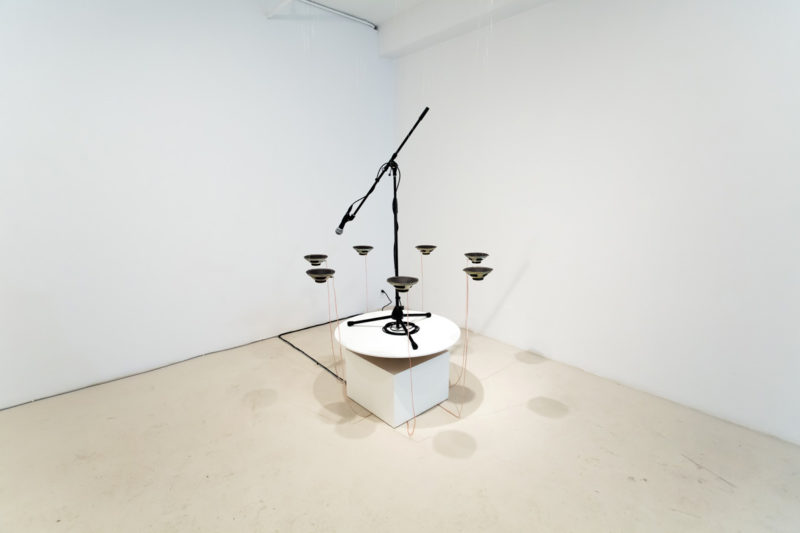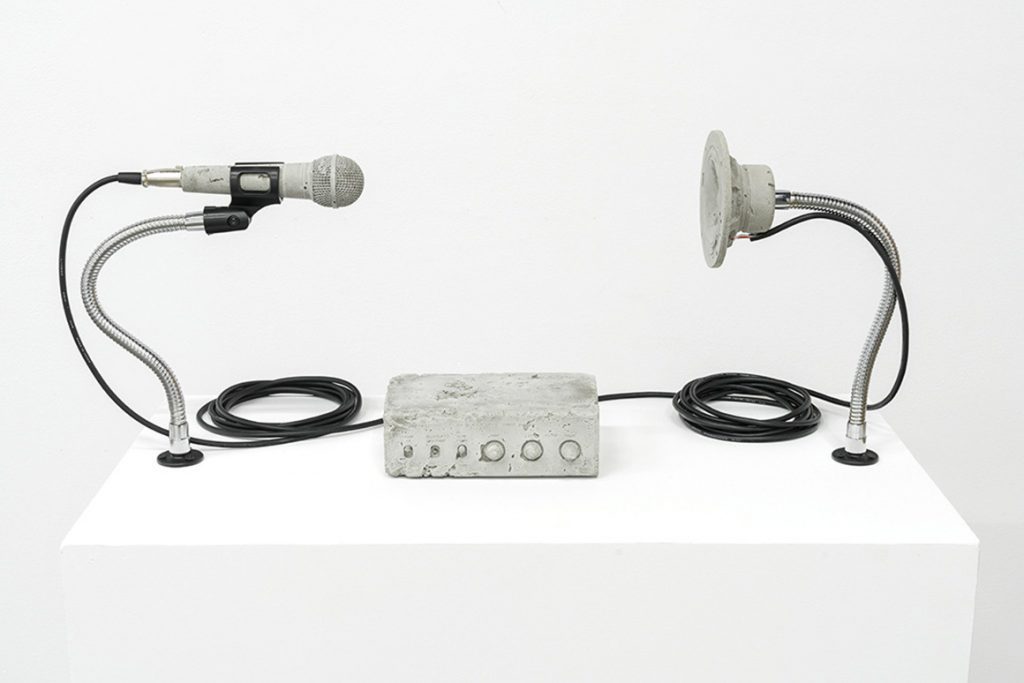Sounds Not Heard: Sound Sculptures by Adam Basanta
13 June 2018
By Shauna Jean Doherty
Adam Basanta’s compositions (whether material or sonic) possess a resonance that deconstructs the foundational principles of acoustics: his work sees sound, composes silence, and locates melody in the din of a hum. Through the creation of sculptures that oscillate between the absence and presence of sound, Basanta reflects on a contemporary climate saturated by noise, proposing strategies of feedback and silence as methods to counteract a deafening modern landscape. Through this technical finesse his creation of sound-based systems intervenes in the social, material, and spatial processes inherent in auditory experience. (1)
The artist’s studio is nestled in a former manufacturing building in Montreal, on a street populated by similar spaces, many of which are à louer. Along with four other artists, Basanta has called this high-ceilinged warehouse his studio since 2014. His cluttered workspace offers little in the way of solitude. A dozen rotating fans are cloistered on the floor beside his cement casts of sound equipment, discarded speaker components, and dozens of realistic-looking foam finger tips in a bin (the results of his studio mate Patrick Saint-Denis’s research for an upcoming project).
When I arrived, Basanta had arranged his sound sculpture, A Line Listening To Itself (2016) on the grey-carpeted floor of his workroom. The piece consists of a series of seven scavenged speaker cones linked by wires that release a rolling harmony. The sound emanating from the rakish assemblage originates from a singular microphone tilted towards the array of speakers. As the mic listens to its own amplification, a seven note feedback chord is produced, each note emitting from an individual speaker in the line. The work’s final composition is influenced by the acoustics of the space and is unified by an algorithm. After a five-minute cycle the room returns to silence.
The configuration of this sound sculpture violates the first rule of sound amplification—pointing a microphone directly to a speaker is forbidden due to the risk of howling feedback (a phenomenon that occurs when the output of a system is directed back into its input). Given its positioning, the installation threatens to produce this ear-piercing effect but instead delivers a pleasant, ringing soundscape.
Here, Basanta instrumentalizes feedback as both a formal component and a conceptual provocation. A loop of audio feedback, or, a microphone hearing itself has the insidious capacity to deafen both itself and its listener. The installation exploits the potential of this threat through its capricious instability, leaving its audience feeling appropriately cautious. A Line Listening To Itself extends itself as a metaphor for the contemporary political climate, whether it be the ongoing activities of the Trump administration or the conservative turn in provincial politics. In an era of political grandstanding, xenophobic policies, partisanship, and insularity, A Line Listening To Itself illustrates the risks of feedback loops and the dangers that emerge when one singular voice is amplified so exponentially that it begins to degrade. The work pointedly asks its viewer to pay critical attention to the sounds that deserve amplification and the deafening effects of a singular sound source.
By distilling the wide category of mass media down to the basic tools of a public address (a microphone and speakers), Basanta further proposes the insertion of feedback as a politicized strategy to disrupt basic flows of information, sonic or otherwise. The work frames feedback as a fractured gesture, falling within author of Feedback: Television Against Democracy, David Joselit’s definition, “as a parasitic and catastrophic mode…that can invade and transform systems.” (2)
Basanta’s sound sculptures frequently ask the viewer to consider the distributed and contextual experience of listening while mobilizing the physical potential of sound. The artist locates the tangibility of sonic phenomena by integrating and experimenting with the tools used to make it, the space in which it is experienced, and the individual who receives it.
In the 2015 solo exhibition, The Sound of Empty Space, featured at Montreal’s Galerie B-312, Basanta exhibited three sculptural works that examined sound conceptually through material experimentation. Each work manifests as a discrete sound system that draws attention to the mutability of sound and, by extension, communication through the deconstruction of the technologies that transmit it. This collection of works demonstrates the artist’s ongoing concern with the relationality of sound and noise, and the extent to which aural phenomena are enfolded within cultural, political, and economic relations.
Pirouette (2015) was the first artwork in which Basanta incorporated physical objects with sound, a departure from his previous practice as a music composer. Featuring a microphone on a stand encircled by seven speakers, Pirouette produces a one-minute melody from Tchaikovsky’s “Swan Lake,” played at a tempo five times slower than the original. As the microphone, which is mounted on a rotating platform performs its graceful spin, feedback is generated—which affects the volume of the notes depending on the proximity to the surrounding speakers. As for the score—the classic Russian love story of power, tragedy and self-sacrifice—which is here retold by replacing human actors with audio, prompts an examination of technology acting as extensions of ourselves. The results of experiencing this work produces a dynamic tension between visual elegance and sonic disorder while foregrounding the tactility of that which can be heard.

Like Pirouette, Vessel (2015) achieves its conceptual framework through its kinetic elements and enclosed system of sound. Composed of a lavalier microphone and a small speaker placed on a linear track inside a large jar, Vessel conjures the same curiosity as a ship in a bottle. As the speaker inside the jar moves away and towards the small microphone, the pitch alters, emitting a ringing tune on loop, typical of Basanta’s artworks. Lavalier mics are most frequently used to capture and amplify the human voice. In Vessel, the system instead amplifies the ambient sound in a sealed space, exploiting the natural resonance of the glass object and decentralizing the role of human-made sound, while drawing the listener in to perceive other frequencies. Basanta deconstructs the elements of a conventional sound system by merging the speaker and the microphone so that they rely on each other rather than mobilizing them as related components. This simple-looking sculpture examines relational acoustics and principles of feedback, concepts that are also examined in The Loudest Sound In The Room Experienced Very Quietly (2015).
Made of a soundproof aquarium that houses a microphone, a public address amplifier, and a speaker cone, The Loudest Sound is a communication ecosystem that the artist intentionally disrupts and renders silent. The singular speaker contained in the unit produces a tone that registers at 120 decibels. The volume is measured by a sound metre positioned within the case, which at intervals reaches its maximum threshold. Despite the ear-piercing noise of the composition, the sealed container allows only a small amount of sound to escape, manifesting as a barely audible high-pitched ringing for the listener. The intensity of the sound is all but entirely damped by the chamber in which it is contained. This installation enacts a process of futility, wavering between potential and impotence, while the message the system attempts to transmit is muted and never fully received due to a process of silencing made material.
The dynamic between noise and silence so relied upon by the artist in this and other works draws its conceptual strength from the legacy of John Cage’s 4’33”. Cage’s silent music composition, first performed by David Tudor in 1952 in upstate New York, drew attention to the rhetorical and discursive dimensions of silence. Cage’s experiments as a conceptual artist and noise musician called for a renewal in approaches to listening and has since generated an entire framework for the reconsideration of the mechanics of sound. (3)
Like 4’33”, Basanta’s series of engraved multiples entitled Plugs (the most important thing) (2016) invites the viewer to concern themselves with the sounds that typically go unnoticed, continuing an investigation of the aesthetics of silence that, since Cage, now seems appreciably less avant-garde. Owners of the multiples receive a set of instructions that lead them on an internal soundwalk. Users are prompted to listen especially to the sounds emanating within the body rather than from external sources. Plugs offers its users respite from the modern world, facilitating a contemplative quiet and a much needed opportunity to tune out.

This year Basanta took his auditory explorations to their conceptual conclusion in the ongoing project Sounds Not Heard (2017-ongoing). Similar to Plugs, the artist departs entirely from the conspicuously audible, examining instead the tools through which sound is engineered and the conventions that govern acts of hearing and listening. The pieces that comprise the series feature casts of sound equipment. In Density as a physical property (2017), for example, two microphones and an audio mixer are formed with concrete. Likewise, in Almost not even there at all (2017) the same tools are composed of resin. The series, in its highly aestheticized presentation, ruminates on the rarity, weight, and materiality of silence.
This evolution of Basanta’s practice is a direct response to our current cultural context. Surrounded by the dystopian noise of endless social media threads, 24-hour news cycles, and the sonic elements of discordance and distortion that accompany them, the artist has gone from using feedback as a disruptive strategy to using silence as a way to remove oneself entirely from the system of overwhelming information flows. The impulse towards quieting the overload of acoustic information in contemporary life is justified, but the reality is that, as John Cage famously observed, there’s no such thing as silence; there’s simply the choice to listen.
- “Introduction.” Music, Sound and Space: Transformations of Public and Private Experience, by Georgina Born. Cambridge University Press, 2015, p. 25.
- Joselit, David. Feedback Television against Democracy. The MIT Press, 2010, pg. xiii.
- Gann, Kyle. No Such Thing As Silence. Yale University Press, 2011, pg. 2.
Feature image: Density as a Physical Property, 2017 by Adam Basanta. Photo by Guy L’Heureux.



